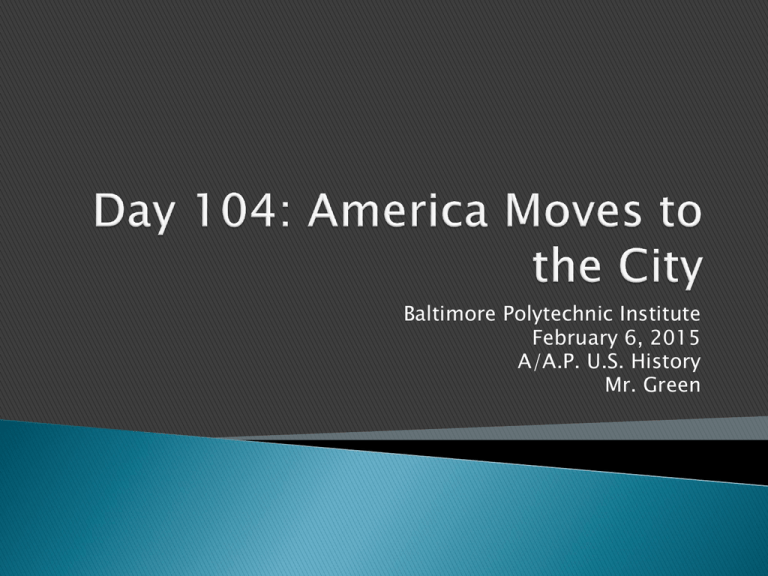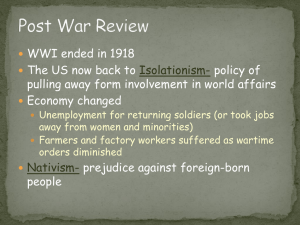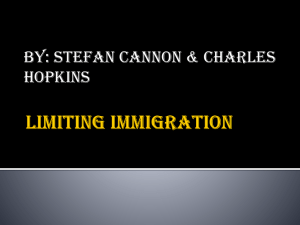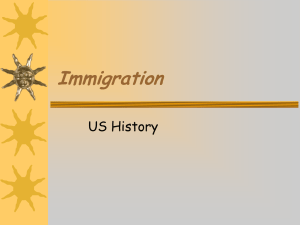AP_104nd_Day_Feb_6_2015 - Baltimore Polytechnic Institute
advertisement

Baltimore Polytechnic Institute February 6, 2015 A/A.P. U.S. History Mr. Green Objectives: Students will: Describe the rise of the American industrial city, and place it in the context of worldwide trends of urbanization and mass migration (the European diaspora). Describe the New Immigration, and explain how it differed from the Old Immigration and why it aroused opposition from many native-born Americans. Discuss the efforts of social reformers and churches to aid the New Immigrants and alleviate urban problems, and the immigrants’ own efforts to sustain their traditions while assimilating to mainstream America. AP Focus Industrialization sparks urbanization, and cities become magnets for immigrants. Those who can afford to leave behind the hustle and bustle of urban life move to the budding suburbs. See the table in The American Pageant (13th ed., p. 560/14th ed., p. 598). Demographic Changes is an AP theme. The late nineteenth century sees a surge of immigration, now from eastern and southern Europe. Most encounter living and working conditions not appreciably better than what they had left. The tenement floor plan (13th ed., p. 561/14th ed., p. 599) shows typical living conditions for impoverished urban workers. CHAPTER THEMES In the late nineteenth century, American society was increasingly dominated by large urban centers. Explosive urban growth was accompanied by often disturbing changes, including the New Immigration, crowded slums, new religious outlooks, and conflicts over culture and values. While many Americans were disturbed by the new urban problems, cities also offered opportunities to women and expanded cultural horizons. Begin reading chapter 25 Multiple Choice on Fri/Essay on Tuesday 1890s Decade chart due on Tuesday Cities across the world expanded Impacts of urbanization commuters-electric street cars, subways urban lifestyle attraction consumerism rather than virtues of thrift skyscrapers crime sanitation slums, dumbbell tenements fires This chart shows the percentage of total population living in locales with a population of twenty-five hundred or more. Note the slowing of the cityward trend from 1970 on. 2 million immigrants between 1850s and 1870s 5 million in the 1880s Prior to 1880-British Isles/Western EuropeGermany/China After 1880-southern/eastern Europe Italians, Jews, Croats, Slovaks, Greeks, and Poles 19% of immigrants in 1880s-early 20th century 66% of immigrants European Diaspora A dispersion of a people from their original homeland European cities growing vigorously as a result of fish/grains from U.S. cultivation of the potato America letters Profit-seeking Americans Savage persecutions Birds of passage-25% between 1820-1900 Immigrants received no support from federal and state governments Many turned to city “bosses” Bosses traded jobs/services for votes “Social Gospel” churches address social issues of the day Jane Addams Hull House in Chicago 1889 Settlement houses women’s activism/social reform Women workers were single, as work for married women was taboo Native born Americans concerned with the New Immigrants religion culture high birthrate not Anglo-Saxon-they would disappear corruption cheap labor political beliefs American Protective Association Anti-Catholic Use as strikebreakers, hard to organize 1882-paupers, criminals, convicts and Chinese 1885-banned foreign workers under contract 1886-Statue of Liberty Liberal Protestants rejected biblical literalism stories as models for behavior Roman Catholics 1900-largest single denomination Judaism Salvation Army-from England Church of Christ, Scientist-heal the sick YMCA, YWCA 1. What new opportunities and social problems did the cities create for Americans? 2. In what ways was American urbanization simply part of a worldwide trend, and in what ways did it reflect particular American circumstances? How did the influx of millions of mostly European immigrants create a special dimension to America’s urban problems? 3. How did the New Immigration differ from the Old Immigration, and how did Americans respond to it? 4. How was American religion affected by the urban transformation, the New Immigration, and cultural and intellectual changes? Begin Reading 1st ½ of Chapter 25 Prepare for 5 question reading check on first ½ of Chapter 25 on Monday Begin working on 1890s decade chart Test on Fri/Monday











